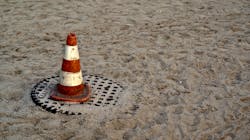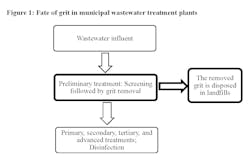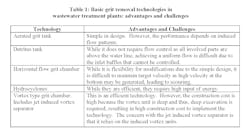The presence of grit in wastewater treatment can contribute to equipment wear and cause abrasion and clogs in wastewater treatment plants (WWTPs) including in municipal WWTPs. This damage depends on the composition and quantity of grit. However, there are technologies to remove grit. What is grit? What are the technologies implemented by WWTPs to remove grit? Are there any regulations for grit removal facilities? And what about the cost for removing grit in municipal WWTPs?
What is grit?
Grit is both organic and inorganic material with a wide size range from 140 microns to 300 microns or more found in the influent entering a municipal WWTP. Grit particles of 1,588 microns (1/16 inches) have also been reported and removed from municipal WWTPs.
Grit includes solid material entering the sewage influent from a variety of sources including from domestic wastes. Eggshells, bone chips, seeds, coffee grounds are organic and sand, gravel, and cinder are inorganic examples of grit material in municipal wastewater influent.
The composition and size of grit particles
The composition and size of grit particles depend on the geography and the weather. A study done using samples from the Atlantic County Regional WWTP showed that the particle size distribution of grit at the plant varied seasonally. More coarse grit particles were found in the plant influent in the summer while finer particles (150 µm or less in size) were found in the winter.
Grit removal is done in the preliminary treatment in municipal WWTPs (Figure 1). Screening is completed before grit is removed. Bar screens are used to separate large material to prevent clogs and to allow the influent flow.
What is grit removal?
Grit removal generally involves using sedimentation technologies prior to primary treatment in municipal WWTPs (as shown in Figure 1) and the removed grit is generally disposed of in landfills.
The WWTP in the City of Saint Peter, Minnesota is a general example to illustrate the grit removal process. After the screening process to remove large material, a vortex grit removal system is used to remove the grit. In this, due to the spiral follow pattern of the water, grit settles to the bottom and is then removed. Then using a hydrocyclone, the grit is washed and dewatered before it is disposed into a landfill.
Why is grit removal necessary in municipal wastewater treatment?
The presence of grit in the wastewater influent can damage equipment and clog pipes, pumps, and valves. Also, the abrasion from the grit can cause undue wear on the different parts and all these collectively impair the downstream treatment processes in a municipal WWTP.
The repair could be costly. For example, the cost of cleaning out the grit deposits in digesters range between $100,000 to $200,000 per digester. To avoid costly repairs, it is important to remove grit from the municipal WWTPs and this removal is described below.
How does grit removal work?
There are several sedimentation technologies for grit removal and they all work on the principle of high speed, turbulent water flow causing the grit particles, due to their specific gravity, to deposit at the bottom of the chamber.
Some of these basic technologies are outlined in Table 1 and they involve either aeration or moving of the mechanical parts to create the horizontal or vertical turbulence in the influent to remove the grit. While some of the technologies are simple in design or flexible for modifications, they also have their challenges including high construction cost and the difficulty in maintaining the target velocity.
Grit removal calculation
The amount of grit removed in cubic feet per million gallons of flow is found by dividing the volume of grit in cubic feet by the flow in million gallons.
Understanding the specific gravity and settling velocity of grit
The specific gravity indicates how much heavier or lighter a material is than water. It is the ratio of the weight of a given volume of material to the weight of an equal volume of water. If a particle has a specific gravity greater than one, it means that it has a weight heavier than water and it will eventually settle in still (quiescent) water. The specific gravity is correlated to the settling velocity of a material.
The settling velocity is defined by Stokes Law and in a sedimentation tank, it also depends on the water temperature and the amount of total suspended solids (TSS) in the wastewater. Particles settle faster in the presence of higher concentrations of TSS than in lower concentrations of TSS. The size of the grit particles and the depth of the water are also among the factors that affect the settling velocity of grit particles in a WWTP.
Factors that affect grit removal
The following factors affect grit removal in a WWTP.
Grit channel velocity
The number of channels in the tank affect the flow of the influent containing the grit in the WWTP and the flow in turn affects the velocity. The optimal velocity in the sewer is usually higher than when the flow reaches the grit channel to prevent solids from settling. When this flow reaches the grit channel, the velocity is decreased to allow the grit particles to settle.
Settling time for grit
The depth of the grit chamber and the settling velocity of the grit particles affect the settling time for the grit in the preliminary treatment process within the WWTP.
Required channel length
The length of a channel affects grit removal. How long of a channel is required depends on the depth of the channel and the settling velocity of the grit particles. Wider channels require a longer length than shallow channels to achieve the same settling velocity of the grit particles.
Design factors for grit removal in WWTPs
The EPA published a report that discussed factors to consider in the design, operation, and in the maintenance of preliminary treatment systems for the removal and handling of grit. Grit removal is required for effluents from sanitary sewers, a system of underground pipes carrying domestic sewage to a WWTP.
The factors to consider in the design for grit removal in WWTPs include the degree of corrosion in the sewer systems, the scouring velocities in the sewer systems, the degree to which household garbage grinders are used, and the presence of open joints and cracks in the sewer systems.
Grit removal regulations
Several states have regulations on the operational design for grit removal facilities. For example:
- The Virginia Administrative Code 9VAC25-790-510 on grit removal facilities includes the design requirements for horizontal flow basins and aerated chambers.
- The Texas Commission on Environmental Quality (Chapter 217 – Subchapter E, §§ 217.120-217.129) includes the velocity in the grit chambers and requirements for aerated grit chambers, for cyclonic degritters, and vortex grit chambers.
State laws are there for grit removal facilities and while they vary, they serve as a guidance for the operation of these facilities to achieve optimal grit removal.
The National Primary Discharge Elimination System (NPDES) requires NPDES permit holders for biosolids or sewage sludge treatment processes to provide information on sludge grinding and degritting and on grit removal for Publicly Owned Treatment Works WWTPs.
The U.S. market demand for grit removal equipment
A market analysis report from Grand View Research shows that the market for wastewater treatment equipment, including grit removal equipment, is increasing annually. From a global perspective, this market size was valued at $12.12 billion in 2019 and is expected to grow at a compound annual growth rate of 3.5% from 2020 to 2027.
There are several factors for why there is an increasing demand for grit removal equipment, and among them is the concern over aging pipelines that result in overflowing sanitary sewers (more than 23,000 to 75,000 every year in the U.S. according to the EPA). Along with cracked pipelines, they lead to grit in the WWTPs. Consumer habits also play a role. More users are connected to wastewater centralized treatment systems and more food waste is disposed into the sink or via disposers, leading to increased quantities of grit entering the municipal WWTPs.





